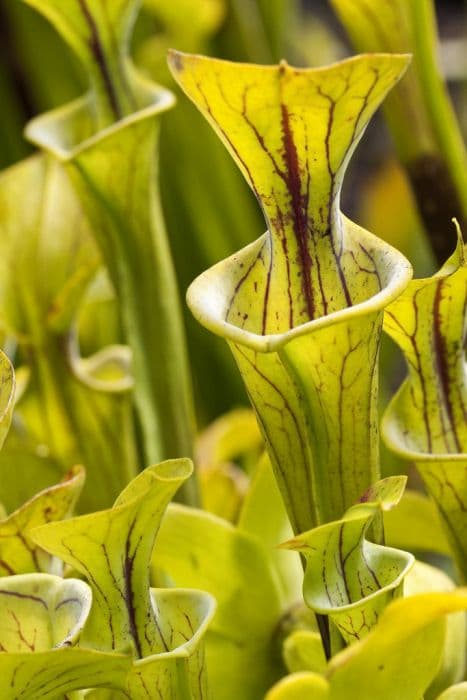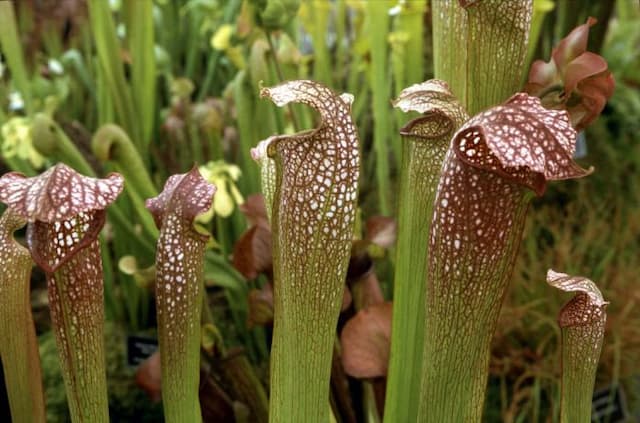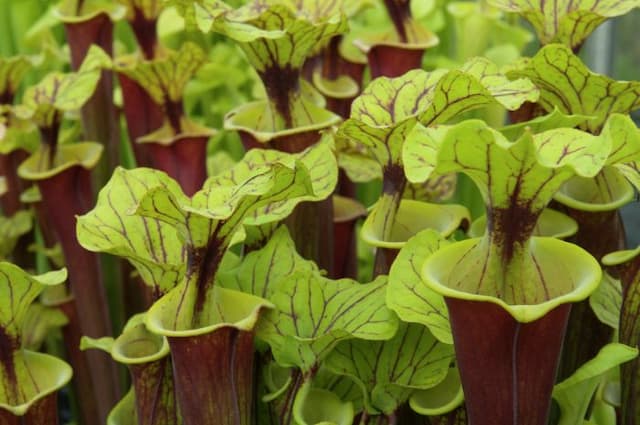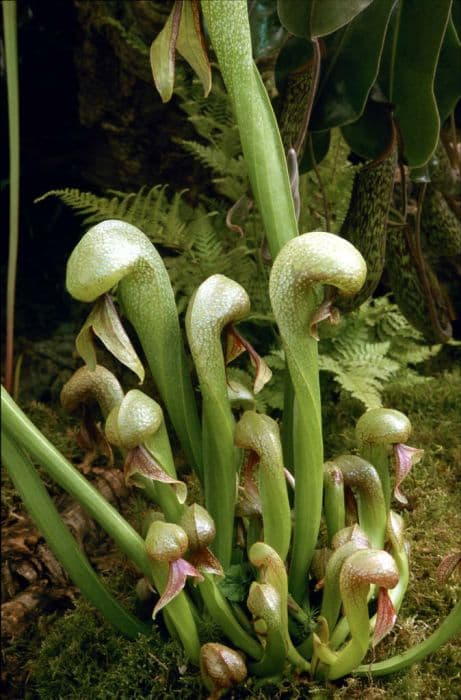Trumpet Pitcher Plant Sarracenia 'Dixie Lace'

ABOUT
The Sarracenia 'Dixie Lace', commonly known as the Dixie Lace Pitcher Plant, showcases a unique look characterized by its captivating pitcher-like structures that successfully trap insects. These pitchers are fashioned from modified leaves that roll into tubular forms, cleverly acting as pitfall traps. They boast a striking color palette which often includes a blend of greens and reds with pronounced veining that creates a lace-like pattern, contributing to the plant’s name 'Dixie Lace'. The top part of the pitcher, referred to as the hood, serves to prevent excess rain from diluting the digestive enzymes and water inside the pitcher, preserving its effectiveness. This hood may contain translucent areass that confuse prey, leading them to believe there is a way out, thus preventing their escape. The inside of the pitcher is slick and often hosts downward-pointing hairs, adding to the difficulty for insects to climb back up and escape once they have fallen in. The plant exhibits a rosette growth form, with these tubular pitchers emerging directly from the ground, and each plant can sport a number of these traps. Blooms, although not the main attraction, appear as curious umbrella-like flowers before the full development of the pitchers in the growing season. These flowers can add additional interest to the plant's unusual appearance. Overall, the Dixie Lace Pitcher Plant's appearance is designed not just for visual appeal, but also for its survival strategy, preying upon insects to obtain nutrients from environments where the soil is poor in essential minerals.
About this plant
 Names
NamesFamily
Sarraceniaceae
Synonyms
Dixie Lace Pitcher Plant
Common names
Sarracenia 'Dixie Lace'
 Toxicity
ToxicityTo humans
The pitcher plant, which is the common name for Sarracenia 'Dixie Lace', is not considered toxic to humans. There is no significant risk of poisoning from ingesting parts of the pitcher plant, and therefore, typically no symptoms would be expected. However, as with any non-food plant, individual sensitivities or allergic reactions could occur, so it is generally not advisable to ingest any part of ornamental plants.
To pets
The pitcher plant is also not known to be toxic to pets. Consuming parts of this plant should not lead to poisoning in animals such as cats and dogs. As with humans, ingestion is not recommended, and there could be risks of gastrointestinal upset or allergic reactions in some pets due to individual sensitivities.
 Characteristics
CharacteristicsLife cycle
Perennials
Foliage type
Deciduous
Color of leaves
Green
Flower color
Varies
Height
1-2 feet (30-60 cm)
Spread
1-2 feet (30-60 cm)
Plant type
Herb
Hardiness zones
5-9
Native area
North America
Benefits
 General Benefits
General Benefits- Ornamental Value: Sarracenia 'Dixie Lace', commonly known as "Pitcher Plant," has striking trumpet-shaped leaves that add aesthetic appeal to gardens and indoor spaces.
- Insect Control: It naturally helps control pest populations by trapping and digesting insects.
- Low Maintenance: Once established in the appropriate environment, it requires minimal care, making it suitable for busy or forgetful gardeners.
- Education and Interest: Its unique carnivorous lifestyle makes it an interesting plant for educational purposes and can spark interest in botany and the natural world.
- Habitat Conservation: Cultivating endangered plants like the Pitcher Plant can contribute to the conservation of their species and habitats.
- Drought Tolerance: Adapted to poor, often waterlogged soils, these plants can survive periods of drought, sourcing nutrients from trapped insects.
 Medical Properties
Medical PropertiesThis plant is not used for medical purposes.
 Air-purifying Qualities
Air-purifying QualitiesThis plant is not specifically known for air purifying qualities.
 Other Uses
Other Uses- Photographic Subject: Due to its unique visual appeal, the Sarracenia 'Dixie Lace' can be an intriguing subject for photographers, particularly those specializing in macro and nature photography.
- Science Education: This plant can be utilized in educational settings to demonstrate carnivorous plant mechanisms and discuss adaptations in the plant kingdom.
- Artistic Inspiration: Artists may draw inspiration from its distinct form and colors for various forms of artwork, including paintings, textile patterns, and sculptures.
- Water Garden Accent: When planted near water features in temperate gardens, it can provide an unusual and striking visual accent.
- Feeding Frenzy Observation: It can be used to observe and study the natural insect feeding frenzy that occurs around its pitchers.
- Conservation Efforts: As part of conservation education, it could represent the importance of preserving vulnerable species and habitats.
- Ecosystem Education: Included in container gardens or educational displays to show the role of pitcher plants in their native ecosystems.
- Cultural Symbolism: Sometimes plants like Sarracenia 'Dixie Lace' become cultural or regional symbols and can be used to foster local pride.
- Culinary Presentation: Though not consumed, it could be used as a dramatic, non-toxic garnish for plating high-end culinary dishes (provided it has not been exposed to pesticides or harmful insects).
- Floristry: With proper care, it can be integrated into unconventional floral arrangements for events looking for a unique botanical element.
Interesting Facts
 Feng Shui
Feng ShuiThe Pitcher Plant is not used in Feng Shui practice.
 Zodiac Sign Compitability
Zodiac Sign CompitabilityThe Pitcher Plant is not used in astrology practice.
 Plant Symbolism
Plant Symbolism- Rarity: Sarracenia 'Dixie Lace', also known as the North American Pitcher Plant, is a hybrid and therefore symbolizes rarity and uniqueness due to its distinct features.
- Adaptability: As a carnivorous plant that has adapted to nutrient-poor soils by trapping insects, it signifies adaptability and innovation.
- Mystery: The pitcher plant's unusual method of obtaining nutrients gives it a sense of enigma, often representing mystery and intrigue.
- Attraction: With its brightly colored and intricate design to attract prey, it can symbolize seduction and allure.
- Balance: Since the plant balances its need for nutrients by both photosynthesis and trapping insects, it can symbolize equilibrium and balance.
 Water
WaterThe Trumpet Pitcher plant requires consistent moisture and should be watered with about 1-2 inches of rainwater or distilled water per week during the growing season. It’s recommended to keep the plant in a tray of water, allowing the potting medium to wick moisture up as needed. Ensure that the water level does not go below 1 inch in the tray, especially during hot weather. In dormancy during winter, reduce watering but never let the soil completely dry out—maintaining a lower level of around half an inch in the tray should suffice.
 Light
LightThe Trumpet Pitcher plant thrives in full sunlight, so it's best positioned in a spot that receives at least six hours of direct sunlight a day. A south-facing window, or an outdoor location with unfiltered sunlight, is ideal for healthy growth and encouraging the plant to produce its characteristic pitchers. Avoid shaded areas, as insufficient light can lead to weak growth and fewer pitchers.
 Temperature
TemperatureThe Trumpet Pitcher plant prefers warm temperatures ranging from 70 to 90 degrees Fahrenheit during its growing season. In winter, it can withstand cooler temperatures down to around 32 degrees Fahrenheit, which helps it go into dormancy—a necessary period for its health. The ideal growth conditions lie within this temperature range, avoiding extremes that could damage the plant.
 Pruning
PruningPruning the Trumpet Pitcher plant involves removing any dead or brown pitchers to promote better growth and prevent rot. Pruning is best done in early spring before new growth starts. It is generally required once a year, as the pitchers from the previous season die back. Avoid pruning the green, healthy pitchers, as these are still capable of photosynthesis and catching prey.
 Cleaning
CleaningAs needed
 Soil
SoilThe best soil mix for the Pitcher Plant is a combination of sphagnum peat moss and perlite at a 1:1 ratio, ensuring good drainage and aeration. The soil pH should be acidic, around 4.0 to 6.0.
 Repotting
RepottingPitcher Plants should be repotted every 2-3 years to refresh the soil and accommodate their growing roots; repot in late winter or early spring.
 Humidity & Misting
Humidity & MistingPitcher Plants thrive in high humidity conditions, ideally between 50-80%; maintaining this range supports their health and pitcher production.
 Suitable locations
Suitable locationsIndoor
Use bright, indirect light and keep the soil moist for indoor growth.
Outdoor
Place in full sun to partial shade and ensure consistent soil moisture.
Hardiness zone
6-8 USDA
 Life cycle
Life cycleSarracenia 'Dixie Lace', commonly known as the Dixie Lace Pitcher Plant, begins its life as a seed, which requires a period of cold stratification to germinate effectively. Upon germination in spring, the seedling develops a small rosette of carnivorous pitcher leaves designed to attract and trap insects for supplemental nutrition. As the plant matures, it forms a larger clump of pitchers each growing season, with new leaves replacing older ones that die back in the fall. Throughout the summer, the Dixie Lace Pitcher Plant produces tall, nodding flowers on separate stalks that can be pollinated by insects for seed production. During winter, the plant undergoes dormancy, reducing metabolic activities and withstanding frost by dying back to its rhizome. In subsequent years, the cycle repeats as the plant emerges from dormancy, enters the vegetative and reproductive phases, and eventually produces new seeds to complete its life cycle.
 Propogation
PropogationPropogation time
Spring-Early Summer
The Sarracenia 'Dixie Lace', commonly known as a type of Pitcher Plant, can be propagated largely through division, which is a popular and effective method. This process is typically carried out in late winter or early spring, just before or as the plant emerges from dormancy. To propagate by division, carefully remove the plant from its pot and gently separate the rhizomes, ensuring that each division has at least one growth point. These divisions can then be potted individually in a mix suitable for carnivorous plants, usually sphagnum peat moss mixed with perlite or sand. It is essential to keep the newly potted divisions well watered, using distilled water or rainwater, to avoid the minerals in tap water, which can build up in the soil and harm the plant. With proper care, the divisions will establish themselves and start to grow, with new pitchers emerging in due time.









